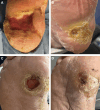Outcomes of a Novel Autografting Procedure Combining Two Synergistic Techniques in One Stage for Improved Wound Healing: Two Case Reports
- PMID: 39712373
- PMCID: PMC11661756
- DOI: 10.1097/GOX.0000000000006369
Outcomes of a Novel Autografting Procedure Combining Two Synergistic Techniques in One Stage for Improved Wound Healing: Two Case Reports
Abstract
Hard-to-heal wounds represent a global and growing medical and economic burden. Skin autografting is a useful treatment option but is often limited by donor site morbidity, logistical considerations, and grafting success in compromised wound beds. Combining autologous skin cell suspension (ASCS) technology with minced dermal grafts can allow for dermal elements and epithelial healing as well as closed donor sites. This study explores the combination of minced autografting with ASCS in healing recalcitrant wounds. Two patients with diabetic foot ulcers (DFUs) whose previous skin grafting had failed were included. Under local anesthesia, donor skin was harvested as a full-thickness ellipse and divided into a superficial split-thickness graft (STSG) and a dermal autograft. ASCS was prepared from the STSG, and the dermal component was finely minced using a scalpel. Prepared wound beds were directly dressed with Telfa clear and compression dressings. Patients included a 62-year-old man with a DFU (15 cm2) on the left plantar heel present for 2 years, and a 53-year-old man with a DFU (10 cm2) on the plantar surface of the first metatarsal head present for 2 years. After combination treatment, complete closure was achieved by days 27 and 24, respectively. There was evidence of continued remodeling and skin thickening for the following 4 months. Combining dermal mincing with ASCS promotes healing of both dermal and epidermal layers while enabling primary closure of donor sites. These initial cases are encouraging, and ongoing studies are validating outcomes in more patients with various hard-to heal wounds.
Copyright © 2024 The Authors. Published by Wolters Kluwer Health, Inc. on behalf of The American Society of Plastic Surgeons.
Conflict of interest statement
Dr. Borrelli assisted with the writing of this article and is employed by AVITA Medical as a Medical Science Liaison. The other authors have no financial interest to declare in relation to the content of this article. The 2 RECELL Autologous Cell Harvesting Devices used in this study were donated for trial purposes.
Figures

Similar articles
-
Comparative Analysis of Autologous Skin Cell Suspension Technology and Split-Thickness Skin Grafting for Subacute Wounds in Medically Complex Patients: Propensity-Matched Cohort Study.J Am Coll Surg. 2025 Jan 1;240(1):34-45. doi: 10.1097/XCS.0000000000001220. Epub 2024 Dec 16. J Am Coll Surg. 2025. PMID: 39431608
-
Split-Thickness Skin and Dermal Pixel Grafts Can Be Expanded up to 500 Times to Re-Epithelialize a Full-Thickness Burn Wound.Adv Wound Care (New Rochelle). 2024 Apr;13(4):176-186. doi: 10.1089/wound.2023.0020. Epub 2023 Dec 11. Adv Wound Care (New Rochelle). 2024. PMID: 37905500
-
Wound Healing and Scar Patterning After Addition of Autologous Skin Cell Suspension to Meshed Grafts.J Surg Res. 2024 Oct;302:925-935. doi: 10.1016/j.jss.2024.08.006. Epub 2024 Sep 13. J Surg Res. 2024. PMID: 39276425
-
A Meta-Analysis of the Outcomes of Metatarsal Head Resection for the Treatment of Neuropathic Diabetic Foot Ulcers.Adv Wound Care (New Rochelle). 2021 Feb;10(2):81-90. doi: 10.1089/wound.2020.1261. Epub 2020 Sep 29. Adv Wound Care (New Rochelle). 2021. PMID: 32870773
-
Bilayered bioengineered skin substitute (Apligraf): a review of its use in the treatment of venous leg ulcers and diabetic foot ulcers.BioDrugs. 2002;16(6):439-55. doi: 10.2165/00063030-200216060-00005. BioDrugs. 2002. PMID: 12463767 Review.
References
-
- Falanga V. Classifications for wound bed preparation and stimulation of chronic wounds. Wound Repair Regen. 2000;8:347–352. - PubMed
-
- Sun H, Pulakat L, Anderson DW. Challenges and new therapeutic approaches in the management of chronic wounds. Curr Drug Targets. 2020;21:1264–1275. - PubMed
-
- Wood FM, Giles N, Stevenson A, et al. . Characterisation of the cell suspension harvested from the dermal epidermal junction using a ReCell® kit. Burns. 2012;38:44–51. - PubMed
Publication types
LinkOut - more resources
Full Text Sources
